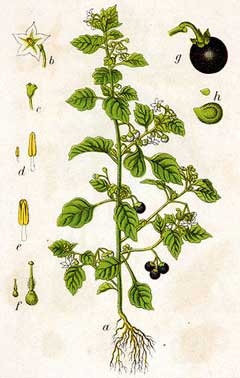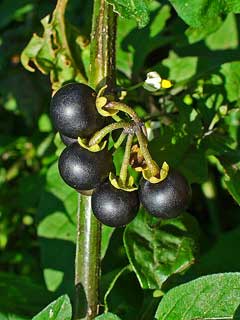 |
|
http://commons.wikimedia.org/wiki/File:Solanum_nigrum_Sturm16.jpg |
 |
| http://commons.wikimedia.org/wiki/User:Llez |
Translate this page:
Summary
Bloom Color: White. Main Bloom Time: Early summer, Early fall, Late summer, Late spring, Mid summer. Form: Upright or erect.
Physical Characteristics

 Solanum nigrum is a ANNUAL growing to 0.6 m (2ft) by 0.3 m (1ft in). It is in flower from July to September, and the seeds ripen from August to October. The species is hermaphrodite (has both male and female organs) and is pollinated by Insects.
Solanum nigrum is a ANNUAL growing to 0.6 m (2ft) by 0.3 m (1ft in). It is in flower from July to September, and the seeds ripen from August to October. The species is hermaphrodite (has both male and female organs) and is pollinated by Insects.
Suitable for: light (sandy), medium (loamy) and heavy (clay) soils and prefers well-drained soil. Suitable pH: mildly acid, neutral and basic (mildly alkaline) soils. It cannot grow in the shade. It prefers dry or moist soil.
UK Hardiness Map
US Hardiness Map
Synonyms
Habitats
Cultivated Beds;
Edible Uses
Edible Parts: Fruit Leaves Shoots
Edible Uses:
Fruit - cooked[2, 27, 89, 179]. Used in preserves, jams and pies[183]. A pleasant musky taste[85]. Somewhat like a tomato, but much less pleasant, it improves slightly after a frost[K]. Only the fully ripe fruits should be used, the unripe fruits contain the toxin solanine[65, 173, 183]. The fruit contains about 2.5% protein, 0.6% fat, 5.6% carbohydrate, 1.2% ash[179]. The fruit is about 9mm in diameter[200]. Young leaves and new shoots - raw or cooked as a potherb or added to soups[2, 27, 85, 89, 173, 179, 183]. This plant is cultivated as a leaf crop in some areas, but see the notes at the top of the page regarding possible toxicity.
References More on Edible Uses
| Composition
|
| Figures in grams (g) or miligrams (mg) per 100g of food.
|
|
|
Leaves (Fresh weight)
|
|
- 42 Calories per 100g
- Water : 86.4%
- Protein: 4g; Fat: 0.7g; Carbohydrate: 7.6g; Fibre: 1.6g; Ash: 1.7g;
- Minerals - Calcium: 210mg; Phosphorus: 70mg; Iron: 5mg; Magnesium: 0mg; Sodium: 0mg; Potassium: 0mg; Zinc: 0mg;
- Vitamins - A: 2000mg; Thiamine (B1): 0.15mg; Riboflavin (B2): 0.15mg; Niacin: 1.2mg; B6: 0mg; C: 43mg;
- Reference: [ 218]
- Notes: The figures given here are the median of a wide range given in the report.
|
|
Medicinal Uses
Plants For A Future can not take any responsibility for any adverse effects from the use of plants. Always seek advice from a professional before using a plant medicinally.
Antiperiodic Antiphlogistic Antipsoriatic Diaphoretic Diuretic Emollient Febrifuge Narcotic
Purgative Sedative
The whole plant is antiperiodic, antiphlogistic, diaphoretic, diuretic, emollient, febrifuge, narcotic, purgative and sedative[4, 21, 145, 147, 192, 218]. It is harvested in the autumn when both flowers and fruit are upon the plant, and is dried for later use[4]. Use with caution[21], see notes above on toxicity. The leaves, stems and roots are used externally as a poultice, wash etc in the treatment of cancerous sores, boils, leucoderma and wounds[218, 257]. Extracts of the plant are analgesic, antispasmodic, anti-inflammatory and vasodilator[218]. The plant has been used in the manufacture of locally analgesic ointments and the juice of the fruit has been used as an analgesic for toothaches[7].
References More on Medicinal Uses
Now available: PLANTS FOR YOUR FOOD FOREST: 500 Plants for Temperate Food Forests and Permaculture Gardens.
An important new book from PFAF. It focuses on the attributes of plants suitable for food forests, what each can contribute to a food forest ecosystem, including carbon sequestration, and the kinds of foods they yield. The book suggests that community and small-scale food forests can provide a real alternative to intensive industrialised agriculture, and help to combat the many inter-related environmental crises that threaten the very future of life on Earth.
Read More
Other Uses
Soil reclamation
This species has been found to be effective in removing PCB's from the soil and detoxifying them[248]. The plant is more effective in doing this if it is infected with the bacterial parasite Agrobacterium tumefaciens[248].
Special Uses
References More on Other Uses
Cultivation details
Succeeds in most soils[1]. Dislikes shade[1]. Flowers are formed on the old wood[206]. Very tolerant of dry conditions[206]. Caterpillars and slugs are particularly fond of this plant and can totally destroy it[K]. Grows well with clover[18]. Does not grow well with wormwood or white mustard and, when these plants are growing close to S. nigra, they increase its content of toxic alkaloids[18]. Some forms of this plant are cultivated for their edible fruits or leaves[200], see notes about possible toxicity at the top of this page. The leaves of one form are sold in local markets in Greece[148]. Special Features:Not North American native, Naturalizing, All or parts of this plant are poisonous.
References Carbon Farming Information and Carbon Sequestration Information
Temperature Converter
Type a value in the Celsius field to convert the value to Fahrenheit:
Fahrenheit:
The PFAF Bookshop
Plants For A Future have a number of books available in paperback and digital form. Book titles include Edible Plants, Edible Perennials, Edible Trees, and Woodland Gardening. Our new book to be released soon is Edible Shrubs.
Shop Now
Propagation
Seed - sow spring in situ. The seed can also be sown in a greenhouse during the spring if required. Prick out the seedlings into individual pots when they are large enough to handle and plant out in late spring.
Other Names
If available other names are mentioned here
Native Plant Search
Search over 900 plants ideal for food forests and permaculture gardens. Filter to search native plants to your area. The plants selected are the plants in our book 'Plants For Your Food Forest: 500 Plants for Temperate Food Forests and Permaculture Gardens, as well as plants chosen for our forthcoming related books for Tropical/Hot Wet Climates and Mediterranean/Hot Dry Climates. Native Plant Search
Found In
Countries where the plant has been found are listed here if the information is available
Weed Potential
Right plant wrong place. We are currently updating this section.
Please note that a plant may be invasive in one area but may not in your area so it’s worth checking.
Conservation Status
IUCN Red List of Threatened Plants Status :

| Related Plants
|
| Latin Name | Common Name | Habit | Height | Hardiness | Growth | Soil | Shade | Moisture | Edible | Medicinal | Other |
| Solanum aethiopicum | Mock Tomato, Ethiopian nightshade | Shrub | 2.5 |
10-12
| | LMH | N | M | 3 | 2 | 2 |
| Solanum ajanhuiri | Ajanhuiri | Perennial | 0.0 |
9-11
| | LMH | SN | M | 2 | 0 | |
| Solanum americanum | American Nightshade, American black nightshade | Annual | 1.0 |
0-0
| | LMH | N | M | 1 | 0 | 0 |
| Solanum andigenum | Andigena | Perennial | 0.0 |
-
| | LMH | N | M | 2 | 0 | |
| Solanum aviculare | Kangaroo Apple, New Zealand nightshade | Shrub | 1.8 |
8-11
| | LMH | N | M | 2 | 2 | 2 |
| Solanum boreale | | Perennial | 0.0 |
-
| | LMH | N | M | 1 | 0 | |
| Solanum boyacense | | Perennial | 0.0 |
-
| | LMH | N | M | 1 | 0 | |
| Solanum cari | | Perennial | 0.0 |
-
| | LMH | SN | M | 1 | 0 | |
| Solanum carolinense | Horse Nettle, Carolina horsenettle | Perennial | 1.0 |
3-7
| | LMH | SN | M | 0 | 2 | 1 |
| Solanum chaucha | Chaucha | Perennial | 0.0 |
-
| | LMH | SN | M | 1 | 0 | |
| Solanum curtilobum | Rucki | Perennial | 0.0 |
-
| | LMH | SN | M | 2 | 0 | |
| Solanum dulcamara | Bittersweet. Bittersweet Nightshade, Climbing nightshade, Bittersweet, Deadly Nightshade, Poisonous | Perennial Climber | 2.5 |
4-8
| M | LMH | SN | M | 0 | 3 | 0 |
| Solanum fendleri | Wild Potato, Fendler's horsenettle, Texan horsenettle | Perennial | 0.0 |
0-0
| | LMH | N | M | 3 | 2 | |
| Solanum jamesii | Colorado Wild Potato, Wild potato | Perennial | 0.2 |
8-11
| | LMH | N | M | 2 | 0 | |
| Solanum juzepczukii | Rucki | Perennial | 0.0 |
-
| | LMH | SN | M | 2 | 0 | |
| Solanum kurzii | | Perennial | 0.0 |
-
| | LMH | SN | M | 1 | 0 | |
| Solanum laciniatum | Kangaroo Apple | Shrub | 3.0 |
8-11
| | LMH | N | M | 2 | 2 | 2 |
| Solanum linearifolium | Mountain Kangaroo Apple | Shrub | 0.0 |
-
| | LMH | N | M | 2 | 0 | |
| Solanum liximitante | | Perennial | 0.0 |
-
| | LMH | SN | M | 1 | 0 | |
| Solanum luteum | | Annual | 0.0 |
-
| | LMH | SN | M | 1 | 0 | |
| Solanum lycopersicum | Tomato, Garden Tomato | Annual | 2.0 |
10-12
| F | LMH | N | M | 5 | 3 | 3 |
| Solanum lyratum | | Perennial Climber | 2.0 |
-
| | LMH | N | M | 1 | 2 | |
| Solanum maglia | | Perennial | 0.0 |
-
| | LMH | N | M | 2 | 0 | |
| Solanum melongena | Aubergine, Eggplant | Perennial | 1.0 |
8-11
| | LMH | N | M | 3 | 2 | |
| Solanum muricatum | Pepino | Shrub | 1.0 |
8-11
| | LMH | N | M | 4 | 0 | 0 |
| Solanum paniculatum | Jurubeba, Nightshade | Shrub | 2.0 |
10-12
| F | LMH | SN | M | 0 | 4 | 0 |
| Solanum phureja | Phureja, Nightshade | Perennial | 0.0 |
8-11
| | LMH | SN | M | 3 | 0 | |
| Solanum piliferum | | Perennial | 0.0 |
-
| | LMH | N | M | 2 | 0 | |
| Solanum pimpinellifolium | Currant Tomato | Annual/Biennial | 1.0 |
10-12
| F | LMH | N | M | 4 | 2 | 2 |
|
|
Growth: S = slow M = medium F = fast. Soil: L = light (sandy) M = medium H = heavy (clay). pH: A = acid N = neutral B = basic (alkaline). Shade: F = full shade S = semi-shade N = no shade. Moisture: D = dry M = Moist We = wet Wa = water.

Expert comment
Author
L.
Botanical References
17200
Links / References
For a list of references used on this page please go here
Readers comment